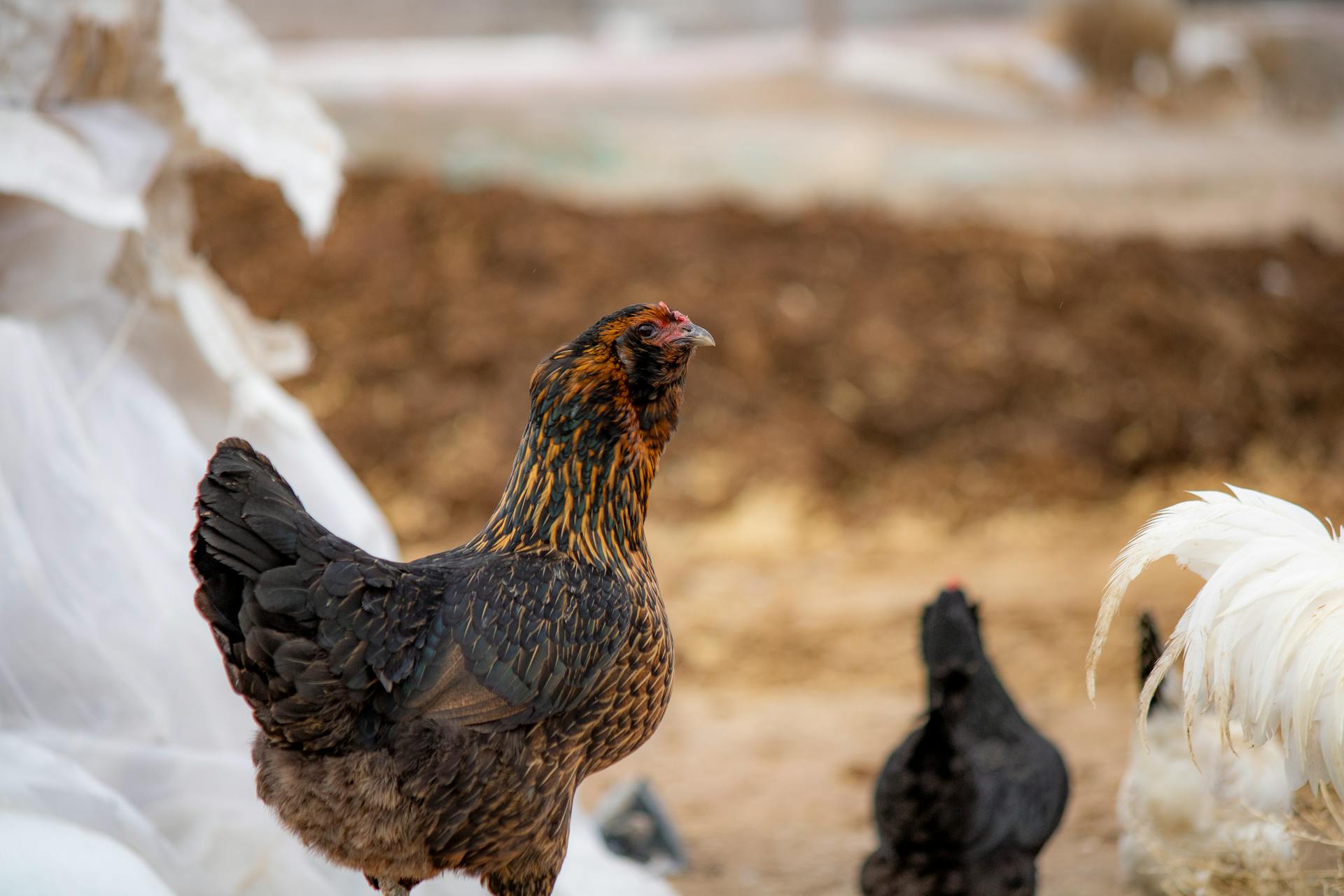
Dogs have been selectively bred for thousands of years, resulting in over 340 recognized breeds. This incredible diversity can be attributed to humans' desire for dogs that excel in specific tasks.
From herding livestock to hunting small game, humans have bred dogs to perform a wide range of jobs. For example, the ancient Egyptians bred dogs to hunt and guard, while the Romans bred them for fighting and companionship.
The process of selective breeding has led to dogs with varying sizes, shapes, and temperaments. Some breeds, like the Greyhound, are bred for speed, while others, like the Bulldog, are bred for their gentle nature.
The result is a staggering array of breeds, each with its unique characteristics and abilities. Whether you're looking for a loyal companion or a skilled hunting partner, there's a breed of dog out there that's perfect for you.
History of Dog Breeds
The history of dog breeds is a long and fascinating one. The first dogs were domesticated from wolves around 15,000 years ago.
Dogs were initially bred for specific tasks such as hunting, guarding, and herding. This selective breeding led to the development of various breeds with unique characteristics.
The ancient Greeks and Romans are known to have bred dogs for companionship and hunting. They valued certain breeds for their intelligence, athleticism, and loyalty.
By the Middle Ages, dog breeding had become more sophisticated, with breeders developing dogs for specific purposes like vermin control and hunting.
The modern concept of dog breeds as we know it today began to take shape in the 19th century. The first breed clubs and kennel clubs were established during this time.
The American Kennel Club (AKC) was founded in 1884 and recognized over 100 breeds by the early 20th century. This expansion of recognized breeds has continued to the present day.
Today, there are over 340 recognized breeds of dogs worldwide. Each breed has its unique characteristics, temperament, and purpose.
Dog Breeds Origin
Dogs have been selectively bred for thousands of years to create over 340 recognized breeds.
The earliest evidence of dog domestication dates back to around 15,000 years ago, with the first dogs likely emerging from gray wolves in the region of modern-day Europe.
Many breeds were developed for specific tasks, such as herding, hunting, and guarding.
The first herding breeds emerged in ancient Mesopotamia around 4,000 years ago, with the development of dogs like the Saluki and the Afghan Hound.
Some breeds were bred for companionship, like the Poodle, which originated in Germany over 400 years ago.
The modern breed of Poodle was developed from an older type of waterfowl-hunting dog called the Barbet.
In ancient Egypt, around 2,000 years ago, dogs were bred for a variety of tasks, including hunting and guarding.
The ancient Egyptians also kept dogs as companions and status symbols, with some breeds being reserved for royalty.
Explore further: Herding Breed Dog
The modern breed of Greyhound was developed from an ancient breed called the Gazelle Hound, which was used for hunting gazelles in the Middle East.
The development of breeds like the Greyhound and the Saluki highlights the importance of geography and climate in shaping the characteristics of dog breeds.
Breeds like the Siberian Husky and the Alaskan Malamute were developed by the indigenous peoples of Siberia and Alaska to pull sleds and hunt in the harsh Arctic environment.
These breeds have adapted to the cold climate and developed unique characteristics, such as thick coats and strong instincts to pull.
New Dog Breeds
New dog breeds have been taking shape for several hundred years. This is a much longer process than the development of cat breeds, which only began in earnest over the last 75 years.
The breeding process for dogs has been ongoing for centuries, with humans selecting for the traits they prefer. This selective breeding has led to the wide variety of dog breeds we see today.
Dogs have been bred for specific purposes, such as hunting, herding, and companionship, which has resulted in a diverse range of breeds.
Why So Many Dog Breeds?
There are over 340 recognized dog breeds, ranging from the tiny Chihuahua to the massive Great Dane.
The first dog breeds were developed over 15,000 years ago, with evidence suggesting that humans began domesticating gray wolves in multiple regions around the world.
Selective breeding has played a major role in creating the vast diversity of dog breeds we see today.
Humans have been breeding dogs for thousands of years, with the earliest recorded evidence of dog breeding dating back to ancient Egypt around 4000 BC.
This selective breeding has led to a wide range of physical and behavioral characteristics, from the high-energy herding breeds to the low-maintenance companion breeds.
Many breeds have been developed for specific tasks, such as herding, hunting, or guarding, which has driven the creation of unique physical and behavioral traits.
The process of selective breeding has also led to the development of breeds with a wide range of coat types, from the short, smooth coats of the Greyhound to the long, fluffy coats of the Old English Sheepdog.
The diversity of dog breeds is also influenced by geographic location, with breeds being developed to thrive in specific climates and environments.
The unique characteristics of each breed have been shaped by their original purpose and the selective breeding that has taken place over time.
Sources
- https://www.akc.org/dog-breeds/
- https://namnguyenwrite.medium.com/where-did-dog-breeds-come-from-5705e5ece771
- https://www.livescience.com/59875-less-variety-in-cats-than-dogs.html
- https://www.caninecommander.com/why-are-there-so-many-dog-breeds/
- https://www.wonderopolis.org/wonder/why-are-there-more-different-types-of-dogs-than-there-are-cats
Featured Images: pexels.com


